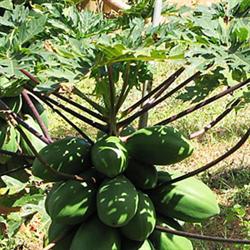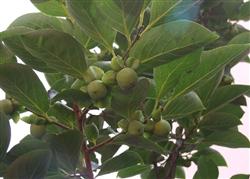Cultivation techniques of papaya
Papaya is a perennial deciduous shrub or small tree of Rosaceae, which is mainly distributed in East China, Hubei, Jiangxi and other places, and is also cultivated in Henan and Hebei. Papaya is used for both food and medicine, mainly for medicinal purposes. Papaya is used as medicine with ripe fruit, which is sour, astringent and warm, and contains many ingredients such as saponins, flavonoids, malic acid, tartaric acid, citric acid and vitamin C. it can relax muscles and activate collaterals and dissolve dampness in the stomach. it is mainly used to treat rheumatism, joint pain, waist and leg pain, vomiting and diarrhea, abdominal pain, limb convulsions and other diseases. There are many kinds of medicinal wine made from papaya in our country, which is very effective in relaxing muscles and activating collaterals, strengthening bones and strengthening bones, so it is a good popular health drink. Papaya is resistant to drought and barren, has no strict requirements for soil, has strong adaptability in mountain areas, and is suitable for cultivation on sloping land, so it is often selected as an excellent tree species for returning farmland to forest. In order to cultivate papaya, it is best to choose a hillside with warm, sunny, fertile, moist, loose and draining water. First, raising seedlings. Seed propagation or cutting propagation can be adopted. The new species of last year should be selected for seed propagation. The seeds are usually sown from March to April in spring. After sowing, the grass was covered with grass to preserve soil moisture, and seedlings emerged in 40-50 days. After emergence, the management of topdressing and weeding should be strengthened and cultivated in the nursery for 2-3 years, waiting for the seedling to come out of the nursery with a height of more than 1 meter. Cutting propagation in February-March papaya branches before sprouting, cut strong and full 1-year-old branches, cut into 20 cm cuttings, obliquely inserted into the seedbed, covered with sunshade net and often sprayed with water to moisturize. After the new root grows, it is moved to the nursery, and the nursery is cultivated for 2 years. Second, the establishment of a garden. It is best to hit the nest in the autumn of the first year, the distance between the nest is 2 meters, and the diameter and height of the nest are more than 80 cm. Mix the fertile and loose ripe soil around the nest and fill the nest with calcium superphosphate (0.5 kg per litter). The raw soil dug up in the nest is piled around the nest and its ripening is promoted by alternating freezing and thawing in winter. Planting is best carried out when the branches sprout in spring, with 1-2 seedlings per hole. Seedlings planted in the nest require the root system to stretch, the root with fine soil cover, step on, and then pour enough water, after the water seepage, backfill the new soil to seal the nest. Third, field management. After the planting of papaya, it is best to spray closed chemical herbicide Hornus or Duer on the tree plate immediately, and then cover with plastic film to keep moisture, which can reduce the work of weeding, improve the survival rate and accelerate the growth of papaya. Otherwise, the tree plate should be ploughed and weeded in spring. In the first two years of papaya planting, dwarf peas can be interplanted between rows in winter, soybeans (4481, 14.00, 0.31%), mung beans, or perennial small herbs can be planted in summer. After papaya planting, topdressing or foliar spraying should be applied to the tree plate in spring and autumn to promote plant growth. The planting head should be fixed for 2-3 years, and should be combined with topdressing wax fertilizer before winter to cultivate the soil to prevent cold. Fourth, pruning. It is carried out in the dormant season from winter to early spring, mainly cutting off withered branches, diseased branches, old branches and over-dense branches to make the whole tree type hollow and round, so as to facilitate more flowering and more fruit. If the tree is old, it needs to be cut down and rejuvenated. Fifth, pest prevention and control. The main cause of papaya virus was blight, and the disease was the most serious from July to August. At the beginning of the disease, brown spots appeared on the leaves, and then expanded to dark brown. In severe cases, the leaves were covered with disease spots, resulting in leaf death. When this disease occurs, the growth period can be sprayed with "green milk copper" to prevent and cure it, and at the same time do a good job of disinfection in winter. Insect pests are mainly heart-eating insects, cabbage insects, aphids and so on. After occurrence, insecticides such as "chrysanthemum EC" and "kung fu EC" can be sprayed to control them. It is found that longicorn beetles can be caught artificially, and the larvae can be stuffed with cotton wool dipped in dichlorvos solution into the wormhole and sealed with yellow mud to kill the larvae. Papaya can blossom and bear fruit in 3-5 years under good cultivation conditions. From July to August every year, when the fruit peel changes from green to yellow, grab the sunny day to harvest, and be careful not to damage the fruit when picking. If the fresh fruit is used medicinally, cut it in half and boil it in boiling water for 5-10 minutes or steam for 10 minutes, then put the bamboo curtain to dry or dry. Dried papaya is best with shrunken skin, strong quality, thick meat, red color and sour taste. If it is to be eaten, it can be processed directly with salt or sugar.
- Prev

Management of cultivation techniques of papaya
(1) varieties. Papaya varieties. (2) Land conditions. From 300m to 900m above sea level, the soil type is yellow brown soil, the thickness of soil layer is more than 50cm, the pH value of soil is 5.3cm to 7.0m, and the content of organic matter ≥ is 1.0%. (3) cultivation and management. 1. Seedling breeding: seedling propagation. The seedling is divided.
- Next

How to manage persimmon after fruiting
Timely fertilization when the transverse diameter of the fruit is 4cm and the fruit size is basically fixed, strong fruit fertilizer and pre-harvest fertilizer are applied, mainly quick-soluble nitrogen, phosphorus and potassium fertilizer, urea 1.5 kilograms, potassium dihydrogen phosphate 0.75 kilograms per tree, or nitrogen, phosphorus and potassium compound fertilizer 1 kilogram, or 1 kilogram after rain.
Related
- Moge, come on! The staff of the peasant association in the producing area of cantaloupe were frightened when the crowd gathered.
- Causes and Solutions of low Fruit setting rate of Apple
- Symptoms and control measures of passion fruit virus disease
- Fruit growing lesson: how do apple orchards keep high yields?
- Can you build orchards in the mountains? What are the pros and cons?
- How to manage the coloring period of Crisson grape?
- This paper introduces the processing technology of two kinds of fig products.
- How much is a month for retired teachers in rural areas by 2020?
- How can strawberry planting increase sugar content? We should pay attention to management in many aspects.
- What are the cultivation techniques on how to improve the yield of golden fruit?

